Executive Summary of Forrester Consulting Project Findings
In January 2015, Topdown commissioned Forrester Consulting to conduct a research study on the way the market thinks about customer communications management (CCM) and customer experience management. Topdown wanted to explore whether and how CCM might merge with digital experience delivery (DXD) platforms used for customer experience management.
One hundred fifty (150) people responded to our survey. The majority of respondents were in:
The respondents represented IT (42%), marketing (16%) and lines of business (27%). All respondents were involved with creating, sending and/or managing customer-facing communications, and the majority (51%) either influenced the buying decision or were the buyer for CCM or DXD technologies.
We were gratified to see a strong interest across the board in what we are investigating and the kinds of solutions we are exploring. The study reveals a strong desire among respondents for the convergence of traditional CCM solutions and emerging customer experience platforms in the near future. Forrester's analysis of the data shows that organizations which unify CCM and web content management (WCM) will receive higher value and improve customer experience versus organizations that keep CCM and WCM separate.
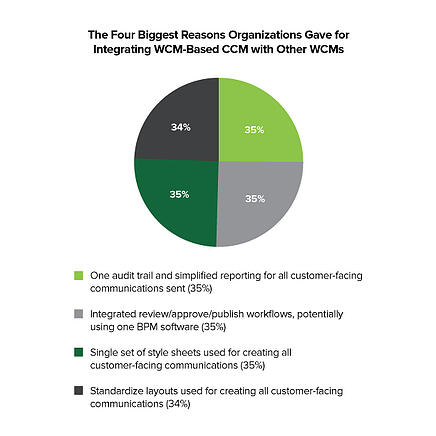
Three major pain points emerged:
The survey results indicate that respondents see significant challenges to effectively addressing these pain points in three main areas: People, Process and Technology
The challenges pertaining to people are the need for strong leadership and the detrimental nature of departmental silos. Of the respondents who are either satisfied or very satisfied with their ability to manage communications across the entire customer journey, 63 percent attribute their satisfaction to a:
These businesses are the happy few that have a CCM champion within their organization – someone who evangelizes excellent customer-facing communication and works to break down silos and barriers within the organization.
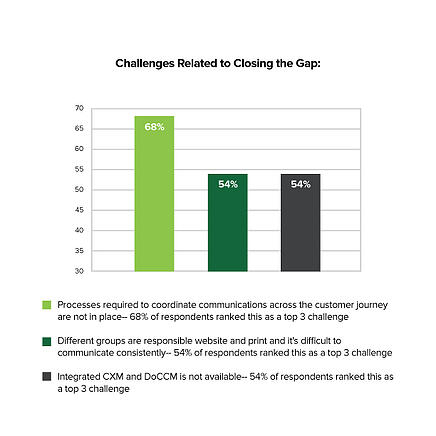 The unsatisfied 88 percent attribute their dissatisfaction to different groups being responsible for different customer touchpoints. In other words, they are suffering from a silo mentality, in which different groups deal with different parts of the customer journey, and they rarely if ever see what other departments are doing. Consequently, customers experience a disjointed, inconsistent and impersonal series of separate interactions with the brand. This, in turn, harms customer loyalty and retention.
The unsatisfied 88 percent attribute their dissatisfaction to different groups being responsible for different customer touchpoints. In other words, they are suffering from a silo mentality, in which different groups deal with different parts of the customer journey, and they rarely if ever see what other departments are doing. Consequently, customers experience a disjointed, inconsistent and impersonal series of separate interactions with the brand. This, in turn, harms customer loyalty and retention.
Another top challenge cited by respondents is that the processes required to coordinate communications across the entire customer journey are not in place. Again, different groups within the organization are acting separately on different means and methods of interacting with customers along their journey.
Employees do not see what goes on elsewhere and focus narrowly on just the communications sent by their own department. There is no process in place for merging communications across channels or business units, and there is no accountability for ensuring consistency, accuracy or efficiency across the gaps. Again, what’s needed is enterprise-wide buy-in to a broad, integrated solution that is properly aligned with overall business goals, human resources and technology.
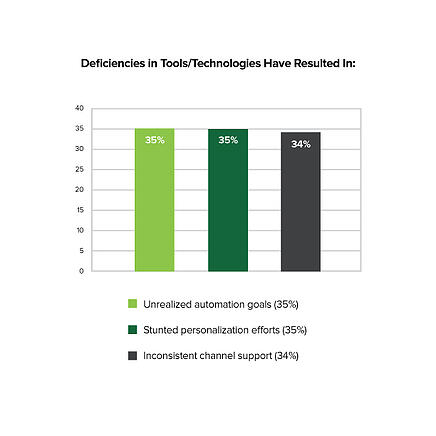
Moreover, in most large organizations, data and assets are scattered across multiple systems, and several enterprise software suites compete with each other for system resources, including server space, database access and system bandwidth. Any efforts to integrate and optimize such systems can cost hundreds of IT man-hours to address. Overworked IT departments often struggle to keep current systems running smoothly and therefore find it nearly impossible to properly address future needs in the present. They need tools that are built to be integrated and are designed to be used by business managers rather than technologists.
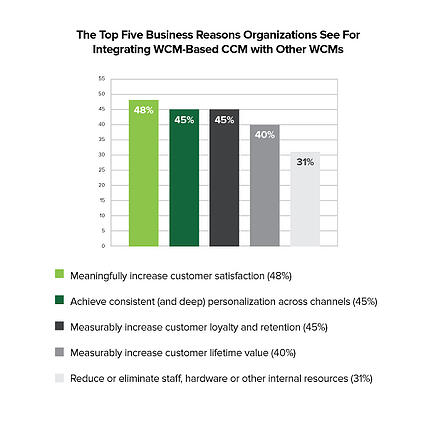
Integration and alignment of people, processes, and technology across the enterprise and throughout the customer journey addresses all these challenges.
By integration, we mean both technological integration – the ability for software tools to “talk” to each other within the system and the consolidation of data across the enterprise via a WCM-based platform – and functional integration of people and processes, or breaking down silos by enabling an internal culture of communication.
Alignment refers to matching the organization’s allocation of people, processes and technology with CXM-related business goals, particularly those of personalization and automation, which respondents identified as particular challenges within their current CCM solutions.
The business benefits are clear. According to our study, respondents’ top reasons for wanting to integrate WCM-based CCM with their customer service platform would be to (in order of priority):
Note that these are all customer-focused metrics, which represents a shift away from a focus on operational metrics or cost savings. Reducing or eliminating internal resources and software license/maintenance expenses are low on the list.
In addition, respondents identified these benefits of integrating a WCM-based CCM solution with other WCMs:
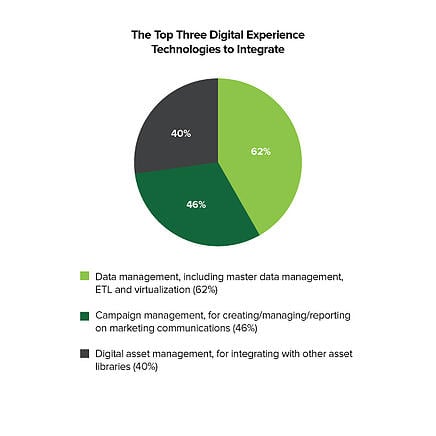
The top three digital CXM technologies survey respondents would like to be able to integrate are data management,campaign management, and digital asset management tools. Of these, data management tools—including master data management, ETL and virtualization tools—constituted by far the largest response.
It is not possible to properly align CXM efforts throughout the customer journey without effective data management in place. In order to personalize customer-facing communications, employees need access to accurate, relevant and consistent customer data. In order to keep communications consistent across operations, all departments involved with customer communications must have access to the same data. And, perhaps most importantly, automation relies completely on accurate mapping to customer data as well as the ability to draw upon shared digital assets as reusable objects.
As the number and variety of channels through which customers can and do interact with brands proliferates, the ability to automate communications that are still highly personalized, properly branded, relevant and timely will become more and more crucial to companies’ ability to compete in the marketplace. Multi-channel is now omni-channel, and customers quickly become frustrated when they cannot get the responses they need via the channels through which they prefer to interact.
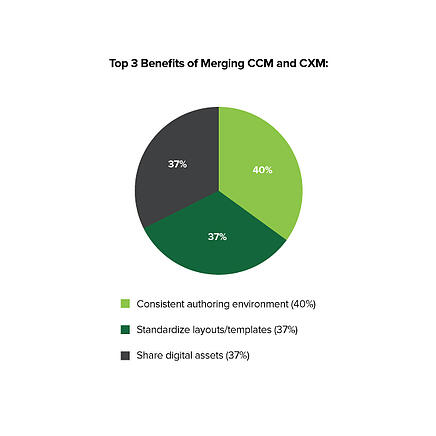
A WCM-based CCM solution would allow brands to address these issues to meaningfully increase customer satisfaction by achieving consistent and deep personalization across channels. This, in turn, would increase customer lifetime value while reducing operational costs.
Very few respondents – only three percent – felt they would not see any business benefits from combining CCM and CXM under a WCM-based platform. The other 97% of respondents could foresee several benefits to such a solution. And 94% of respondents want to integrate a WCM-based CCM solution with the other WCMs in their organizations.
Using a WCM-based CCM solution would provide a consistent authoring environment for all channels and customer lifecycle stages. Layouts, content and digital assets could be shared among systems. And organizations could begin to standardize on taxonomy, data management tools and other technologies.
These are just some of the key findings and insights we are gleaning from this very revealing study. The full research report contains information about the specific features and deployment options organizations want in a WCM-based CCM system. To learn more about our recommendations and future direction, subscribe to the Topdown blog or follow Topdown on Twitter to receive more details on the research as we release them.
Copyright © 2025 Top Down Systems Corporation. All Rights Reserved.
Schedule a call today.